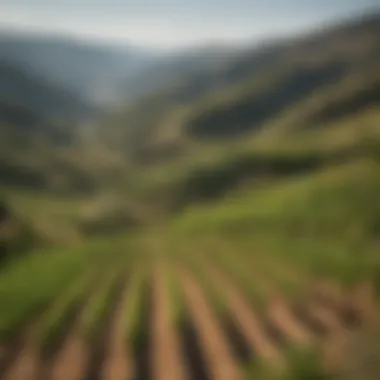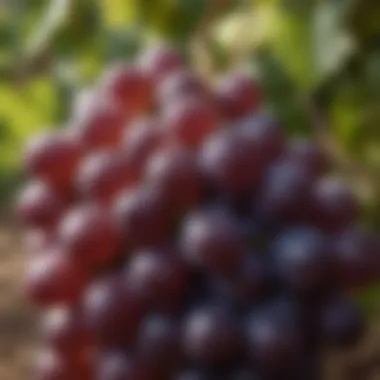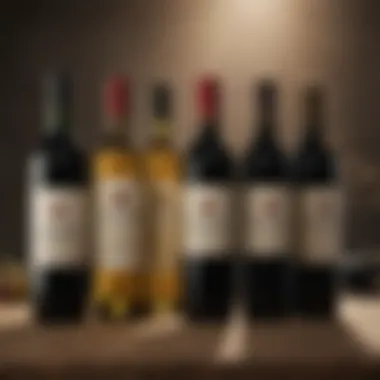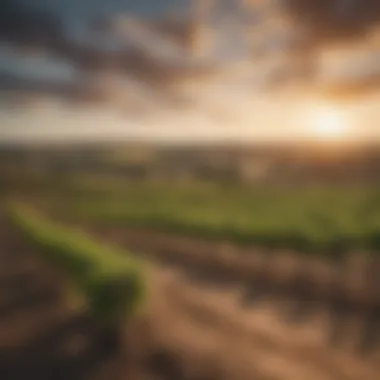Discover the Exquisite Wines of Portugal


Intro
Understanding the intricate tapestry of Portuguese wines is essential for any enthusiast keen on grasping the nuances of global viticulture. Portugal boasts a collection of wine regions that are not only steeped in history but also varied in topography and climate, resulting in a spectacular diversity of wine styles and grape varieties. The country’s unique wine landscape has been shaped by centuries of tradition, cultural influences, and varying local practices.
This exploration emphasizes key aspects, from notable indigenous grape varieties such as Touriga Nacional and Alvarinho to lesser-known regions with emerging reputations. Each section of this article provides a detailed examination of factors that define Portuguese wines, ensuring an understanding of not only what is produced but also the significance behind the production methods and regional characteristics.
"Portugal’s wine heritage is a patchwork of centuries-old traditions intertwined with a modern appreciation for quality and innovation."
The reader will discover not just the wines but also the geographical and climatic influences that contribute to the unique flavors and characteristics of these wines. This knowledge serves both enthusiasts and connoisseurs with insights into selecting wines for various occasions and enhancing their overall appreciation. Delve deeper to uncover the compelling narratives behind Portugal’s vinous offerings.
Intro to Portuguese Wines
Exploring the wines of Portugal offers a remarkable journey into a rich cultural heritage. With centuries of tradition, Portugal boasts a variety of unique wines that reflect the diverse terroirs and climate across its regions. Understanding Portuguese wines is not merely about savoring flavors; it is about appreciating the artistry and dedication that goes into each bottle. This introduction sets the foundation for a comprehensive examination of the complex world of Portuguese wines, providing insight into their historical significance, cultural relevance, and diverse production techniques.
Historical Context
Portuguese winemaking dates back thousands of years, with evidence of vineyards cultivated as early as the Roman era. The Romans appreciated the favorable conditions in regions like the Douro Valley, known for its characteristic steep terraces. Over the centuries, the viticultural landscape evolved. In the 12th century, during the reign of Portugal, winemaking gained prominence as a source of revenue and national identity. The establishment of the first demarcated wine region in 1756, the Douro Valley, was a pivotal moment, paving the way for quality standards in production.
Portuguese wines began to make their mark on the international stage in the 17th century with the export of Port wine to England. The unique method of fortification that distinguishes Port wine lasted the test of time and allowed it to flourish in diverse markets. However, it was not only Port that captured international attention. Over time, Madeira, known for its unique aging process, also became favored, further solidifying the prestige of Portuguese wines.
Today, Portugal remains a dynamic landscape for winemakers. Its history of adaptability and resilience contributes to its current position in the global wine market, where quality often competes with historic reputation.
Cultural Relevance
Wines of Portugal are deeply intertwined with the nation's culture. They embody a lifestyle that goes beyond simple consumption; they are part of social gatherings, culinary traditions, and celebrations. Each region has its signature styles, which are often paired with local cuisines, thus enhancing the dining experience.
The cultural significance of wine extends beyond its role on the table. Festivals celebrate local varietals, bringing communities together in appreciation of their shared heritage. In places like Alentejo and the Douro Valley, locals take pride in their wine culture, which is passed down through generations.
Moreover, wine tourism is an increasingly vital aspect of Portuguese culture. Many wineries now offer tours and tastings, inviting visitors to experience the landscapes and stories behind the wines they enjoy. This interaction fosters a deeper connection between consumers and producers, enhancing the global appreciation of Portuguese wines.
"Wine is sunlight, held together by water" - Galileo Galilei. This quote resonates with the essence of Portuguese wines, intertwining geography, tradition, and passion into a single narrative.
Major Wine Regions of Portugal
The significance of Portugal's major wine regions lies in their distinct terroirs, unique grape varieties, and rich histories. Each region presents a specific set of environmental conditions that influence the style and quality of wines produced. Understanding these regions offers a deeper appreciation of Portuguese wines, providing insights into what makes each area unique. The diversity in these regions contributes to the complexity of the wine landscape, making it essential for enthusiasts and connoisseurs alike to explore these localities.
Douro Valley
Douro Valley is one of the most iconic wine regions in Portugal, recognized not just for its stunning landscapes but also for its exceptional wines. This region is known primarily for Port wine, a fortified wine with a rich heritage. The Douro River cuts through steep terraced vineyards, creating a visually striking environment. The soil is predominantly schist, which retains heat and helps to produce concentrated flavors in the grapes. Common varieties grown here include Touriga Nacional and Tinta Roriz, both integral to the production of high-quality Ports and red wines.
Alentejo
Alentejo is a vast region located in the southern part of Portugal, characterized by warm temperatures and flat terrain. This region has gained a reputation for its bold and fruit-forward wines. The diverse climate allows for a range of grape varieties, such as Trincadeira and Alicante Bouschet. Many producers emphasize modern winemaking techniques, which has put Alentejo on the map for both reds and whites. The wines from Alentejo exhibit ripeness and complexity and are increasingly being recognized on the international stage.
Vinho Verde
Vinho Verde translates to "Green Wine," referring to the young wines typically released shortly after harvest. This region, located in the northwest, is known for producing light and crisp white wines, which often feature a slight effervescence. The grape varieties, notably Alvarinho and Loureiro, thrive in the region's cooler climate. Vinho Verde pairs well with seafood, making it a staple in coastal culinary traditions. The wines are refreshing, showcasing bright acidity and floral notes, appealing especially during warmer weather.
ão
The Dão region is situated in the central part of Portugal, known for its high-quality red wines that often age beautifully. The region benefits from its mountainous terrain, which creates a cooler microclimate. Leading grape varieties include Touriga Nacional and Jaén, both of which are celebrated for their structure and complexity. Dão wines tend to exhibit elegance, combining fruitiness with mineral notes. The traditional winemaking methods here continue to capture the essence of this unique terroir.
Lisbon Region
The Lisbon region boasts a variety of styles that reflect its proximity to the Atlantic Ocean. It features coastal vineyards, which benefit from maritime influences. This area is known for its production of diverse wines, including whites from the Arinto and Fernão Pires grapes, as well as reds from Castelão and Syrah. These wines are often characterized by their refreshing qualities and versatility in food pairings. Additionally, the region's urban wine scene is thriving, attracting those interested in both traditional and avant-garde winemaking.
Grape Varieties
Grape varieties are essential to understanding the distinct character of Portuguese wines. Portugal is famous for a wide range of indigenous grapes. These have developed over centuries, shaped by the unique climates and soils of each region. The importance of these varieties goes beyond mere classification. They are the very foundation upon which Portugal's rich wine heritage is built. Each grape offers a distinct flavor, aroma, and body, reflecting the terroir of its origin.
Indigenous Grapes
Indigenous grapes are key to the identity of Portuguese wines. Varieties such as Touriga Nacional, Tinta Roriz, and Alvarinho contribute significantly to the profile of the country’s wine landscape.
- Touriga Nacional: Known for its bold structure, this grape is often famous in the production of high-end red wines. It is esteemed for its rich tannins and deep fruit flavors, representing the quintessence of Portuguese wines.
- Tinta Roriz: This variety, also known as Tempranillo, thrives in regions with a continental climate. It offers fruit-forward profiles while lending itself well to aging.
- Alvarinho: Commonly found in the Vinho Verde region, this grape stands out for its aromatic quality and refreshing acidity, making it a favorite in white wine production.


"The indigenous varietals tell a story of culture, climate, and craftsmanship. Each sip brings a piece of Portugal along with it."
Indigenous grapes are not only important to flavor profiles but also hold cultural significance. Historical cultivation practices and local traditions have been integral in maintaining these varieties. Winemakers today are increasingly focusing on these indigenous varieties to produce wines that are both authentic and express their land.
International Varieties
While indigenous grapes are a hallmark of Portuguese wines, international varieties have also gained traction. Grapes such as Cabernet Sauvignon, Merlot, and Chardonnay are now grown in various regions. These varieties bring different dimensions to Portuguese wine, attracting a wider audience and enhancing the versatility of selections available.
- Cabernet Sauvignon: Increasingly used in blends, this grape adds depth and complexity to the wines. Its global appeal makes it a staple in many Portuguese wineries.
- Merlot: Soft and supple, Merlot is an attractive option for those new to Portuguese wine, adding smoothness with its fruity undertones.
- Chardonnay: Found in several regions, this varietal benefits from Portugal's diverse climates, producing styles ranging from crisp and mineral to rich and oaky.
The integration of international grape varieties allows Portuguese wineries to expand their portfolios. With the global wine market evolving, the inclusion of these varieties appeals to a broader range of consumers. It reflects a willingness to innovate while still honoring traditional practices.
In summary, the variety of grapes cultivated in Portugal itself creates a vibrant tapestry of flavors and styles. Understanding both indigenous and international grape varieties is crucial for grasping the full breadth of what Portuguese wines offer.
Wine Styles
Understanding the various wine styles is crucial in appreciating the diversity of Portuguese wines. Each style encapsulates not only the grape varieties used but also the winemaking techniques and regional characteristics that contribute to flavor profiles. This section offers insights into the richness of Portuguese wines by presenting their prominent styles. You will find that each style serves unique purposes in culinary pairings and enjoyment, making them a relevant focus for wine enthusiasts.
Red Wines
Portuguese red wines are known for their complexity and depth. The country's diverse climates and soil types favor an array of indigenous grape varieties, resulting in wines that range from light-bodied to full-bodied. Key varieties like Touriga Nacional and Tinta Roriz often create robust, structured wines. These reds pair well with hearty dishes such as grilled meats and rich stews.
Notable Features:
- Rich fruit flavors often dominate.
- High acidity in some styles ensures balanced drinking.
- Aging potential with oak influence can enhance complexity.
White Wines
White wines in Portugal have gained increasing recognition recently. They are often crisp and aromatic, reflecting the cooler coastal climates. Notable varieties, such as Alvarinho and Viosinho, bring refreshing acidity and vibrant fruit notes. These wines are incredibly versatile and can complement lighter fare, like seafood or salads.
Characteristics to Consider:
- Unique combinations of citrus and tropical flavors.
- Increasing popularity of barrel-aged varieties for complex aromas.
- Ability to express terroir effectively, making each region distinctive.
Rosé Wines
Rosé wines hold a special place in Portuguese wine culture. They are crafted mainly from red grape varieties, resulting in delicate flavors and stunning hues. A combination of freshness and fruit-forwardness makes these wines excellent for summer sipping or enjoyable with a variety of dishes, from grilled vegetables to charcuterie boards.
Key Points:
- Often made using direct pressing or saignée methods.
- They range from dry to sweet, appealing to diverse palates.
- Their versatility in food pairings is noteworthy.
Sparkling Wines
Portugal's sparkling wines, particularly those from the Vinho Verde region, offer delightful effervescence. Traditional methods, similar to those used for Champagne, are gaining traction among producers. These wines serve well during celebrations or as an aperitif, showcasing bright acidity and refreshing profiles.
Highlights:
- Often light and easy to drink, suitable for leisurely occasions.
- Potential for complexity when aged correctly.
- Growing global interest in Portuguese sparkling, opening avenues for exploration.
Fortified Wines
Fortified wines are perhaps the most distinctive in Portugal, particularly Port and Madeira. These wines undergo the addition of alcohol during fermentation, resulting in rich, intense flavors. Port, known for its luscious sweetness, pairs excellently with desserts, while Madeira, with its unique aging processes, offers infinite versatility in pairings.
Essentials to Remember:
- Varieties range from ruby and tawny Ports to dry and sweet Madeiras.
- Aging styles impact flavor and texture significantly.
- They serve as an integral part of Portugal's wine legacy, continuously drawing interest from connoisseurs worldwide.
"Each wine style tells a story of the land, the people, and the rich cultural heritage of Portugal, making every sip an exploration."
The Role of Terroir
Terroir is a fundamental concept in wine production, particularly in Portugal where vineyards are influenced by varied climatic, geological, and cultural elements. It is more than just a French word; it embodies the distinctiveness of a region and its potential to produce exceptional wines. Understanding terroir allows one to grasp the nuances and specific traits of Portuguese wines, revealing how the environment interacts with grape varieties and winemaking practices.
Climate and Geography


The climate across Portugal varies significantly, affecting grape growing and wine production. Coastal areas experience a Mediterranean climate, characterized by mild oceanic influences, while inland regions are hotter and drier. This geographical diversity enables producers to cultivate various grapes tailored to their specific location.
For instance, the Douro Valley enjoys a warm climate with hot summer days and cool nights that encourage the development of complex flavors in grapes. In contrast, the Vinho Verde region benefits from more rainfall and a cooler microclimate, leading to the production of light and crisp wines. The Atlantic Ocean plays a crucial role, sending cool breezes inland that temper temperatures in many wine areas, ensuring grapes do not over-ripen.
Additionally, elevation is also a factor. Higher altitude vineyards in regions like Dão benefit from greater temperature fluctuations between day and night, which can enhance the acidity and freshness of the wine. Understanding these climate characteristics is essential for a connoisseur looking to appreciate the regional differences in Portuguese wines.
Soil Types
The soil composition in wine regions can have significant effects on the characteristics of the wine produced. In Portugal, various soil types contribute to the terroir, influencing the taste and quality of the grapes.
Key soil types include:
- Schist: Predominantly found in the Douro Valley, schist soils are known for excellent drainage and heat retention. The roots of vines dig deep into this type of soil, which promotes minerality in the final wine.
- Granite: Common in the Vinho Verde region, granite soils are acidic and well-draining. This results in crisp and aromatic wines, suitable for white grape varieties.
- Clay: Found in areas like Alentejo, clay soils hold moisture well, allowing for better water retention. This benefits the growth of fuller-bodied red wines by providing consistent hydration.
- Limestone: Present in the Dão and Lisbon areas, limestone is important for preserving acidity and freshness in wines, making it ideal for producing high-quality whites and elegant reds.
Each soil type interacts with the local climate and grape varieties, thus sculpting the unique identities of Portuguese wines. Understanding these factors contributes to a deeper appreciation of their complexity.
Wine Production Techniques
The art of winemaking in Portugal is deeply rooted in tradition, influenced by both the past and the present. Understanding wine production techniques is crucial, for they directly impact the quality and character of Portuguese wines. These techniques vary widely across different regions and play a significant role in defining the unique attributes associated with each wine. A focus on the methods used can enhance the appreciation of the diverse offerings that Portugal presents to wine enthusiasts.
Traditional Methods
Traditional winemaking methods in Portugal are steeped in history. Many Portuguese winemakers still employ time-honored techniques passed down through generations. One such technique is the use of lagares, shallow stone troughs where grapes are crushed by foot. This practice helps to release the juice while keeping the grape skins intact, allowing for a more natural extraction of flavors and aromas.
In regions like the Douro Valley, the blending of different grape varieties brings depth and complexity to the wines. The focus on local varieties adds a distinctive character that reflects the region’s terroir. The aging process also typically involves old wooden barrels, which impart subtle flavors without overpowering the fruit.
These methods not only contribute to the authenticity of the wine but also emphasize the importance of quality over quantity. By embracing traditional techniques, many producers manage to maintain the unique identity of their wines, ensuring they resonate with those who appreciate classic craftsmanship.
Modern Practices
As the global wine market evolves, Portuguese winemakers are increasingly incorporating modern practices alongside traditional methods. This blend of old and new helps enhance sustainability and quality control. One notable advancement is the use of temperature-controlled fermentation, which preserves the fresh fruit flavors of wines, particularly whites and light reds.
Winemakers are now also focusing on precision viticulture. This involves using technology such as drones and soil sensors to monitor vineyard conditions closely. Understanding how specific areas of a vineyard respond to environmental factors allows for tailored approaches to irrigation, pest management, and other viticultural practices. This not only boosts grape quality but also promotes more sustainable farming practices.
The introduction of selective harvesting techniques further underscores modern practices. Picking grapes at optimal ripeness ensures that only the best fruit is used in production, leading to wines that reflect the highest standards of quality.
Challenges in the Industry
The Portuguese wine industry faces various challenges that impact its growth and sustainability. These challenges stem from environmental, economic, and social factors. Understanding these issues is crucial for any stakeholder in the wine sector because they affect production, marketing, and overall wine quality. Addressing these challenges often requires innovative solutions and strategic planning, which can ultimately lead to a stronger and more resilient industry.
Climate Change Impacts
Climate change represents one of the most pressing concerns for winemakers in Portugal. The rising temperatures and unpredictable weather patterns can alter the grape growing seasons drastically. Historically, Portugal's diverse climate has been an asset, providing a range of conditions for different grape varieties. However, climate change threatens this balance, leading to various consequences, such as:
- Early Bud Break: Warmer winters can cause grapevines to bud earlier, exposing them to late frosts.
- Water Scarcity: Increased temperatures can lead to drought, complicating irrigation practices.
- Pest and Disease Proliferation: Shifting climates can make vineyards more susceptible to pests and diseases that thrive in warmer conditions.
These factors may lead to a decrease in grape quality and yield, forcing producers to adapt their strategies, such as changing grape varieties or adjusting vineyard management techniques.
Economic Factors
The economic landscape of the wine industry in Portugal is also fraught with challenges. Key issues include:
- Market Competition: Portuguese wines compete with wines from other countries, such as France, Italy, and Spain. This competition can impact pricing and market share.
- Export Limitations: While export opportunities exist, regulatory hurdles and trade tariffs may restrict growth in international markets.
- Investment Requirements: Maintaining and upgrading winemaking facilities or vineyards can require substantial investment. Small producers often lack the financial resources to implement necessary changes or improvements.
"As the industry evolves, it is vital for producers to remain adaptable, balancing traditional techniques with modern practices."
Portuguese Wines on the Global Stage
The presence of Portuguese wines on the global stage has become increasingly significant in recent years. This section delves into the implications of this trend, noting how Portugal's unique terroir, diverse grape varieties, and distinctive wine styles contribute to its standing in the international wine market. By understanding these dynamics, one can appreciate both the potential and challenges faced by Portuguese winemakers.
Export Trends
In the past decade, the export of Portuguese wines has escalated dramatically. This upsurge is driven by various factors, including a growing global interest in unique and less mainstream wine regions. Notably, regions like Douro Valley and Alentejo have become synonymous with quality.
- Market Expansion: Exporting to new markets is vital. The United States, Brazil, and the United Kingdom are among the top importers of Portuguese wines. Efforts to increase visibility in these regions have yielded positive results.
- Online Sales: The rise of e-commerce has transformed how Portuguese wines reach consumers. Winemakers are utilizing platforms like Wine.com and Vivino to expand their customer base beyond traditional distribution.
- Sustainability Appeal: Many consumers today value sustainability. Portuguese wineries increasingly engage in eco-friendly practices. This alignment with global sustainability trends enhances their marketability.


International Recognition
Portuguese wines are garnering recognition at prestigious competitions and by sommeliers worldwide. This acknowledgment highlights both the quality of the wines and Portugal's rich winemaking heritage.
- Awards and Honors: Numerous wines from Portugal have received accolades from global contests, elevating their status. For instance, the Wine Spectator regularly features top Portuguese wines in its annual best lists.
- Sommeliers' Choice: Many sommeliers now regard Portuguese wines as offering outstanding value. The balance of quality and price makes them attractive options in fine dining settings.
- Cultural Events: Wine festivals and tastings throughout Europe and the Americas showcase Portuguese wines, facilitating direct interactions between producers and consumers. This cultural exchange helps demystify the wines and fosters interest.
"Portuguese wines are not just another choice; they represent an experience rooted in tradition and innovation."
In summary, Portuguese wines are making a name for themselves internationally through strategic exports and increasing recognition. As these trends continue, further exploration of regions and styles promises to elevate Portugal’s position in the global wine market.
Pairing Portuguese Wines with Food
Understanding how to pair Portuguese wines with food is crucial to appreciating the full experience these wines offer. Portugal's rich culinary tradition intersects with its diverse wine profile, creating an opportunity for a nuanced exploration of flavors. Effective pairings enhance both the wine and the dish, allowing the characteristics of each to shine through. By choosing wines that complement or contrast with the specific ingredients and flavors in the food, one can elevate not only a meal but also the overall dining experience.
Moreover, Portugal's unique regional dishes are often designed to pair harmoniously with local wines, reflecting the country's geography and climate. The intricate connections between the wines and the food speak volumes about Portuguese culture and heritage. Therefore, learning the specific pairings will enhance appreciation of both the cuisine and its wines.
Regional Dishes
Portuguese cuisine is diverse, comprising rich flavors and regional specialties. Some dishes are synonymous with specific regions, and each of these dishes can be complemented by particular Portuguese wines. Here are a few notable pairings:
- Bacalhau à Brás: This traditional codfish dish is often best enjoyed with a crisp Vinho Verde, which balances the saltiness of the bacalhau.
- Caldo Verde: A potato-based soup featuring greens, typically paired with a light white wine from the Dão region, which adds freshness to the palate.
- Cozido à Portuguesa: A hearty stew with a variety of meats and vegetables, standing up well with a robust red from the Douro Valley, which brings out the rich flavors of the dish.
These pairings go beyond mere suggestion; they offer insight into how local culture evolved with its resources. The synergy between food and wine is a way to celebrate Portugal’s gastronomy.
Wine and Cheese Pairings
Cheese is another essential item in Portuguese cuisine, and it has its own nuances in pairing with wine. Portugal is renowned for its sheep's milk cheese, such as Queijo da Serra, and blending these with the right wines can lead to exciting flavor profiles.
- Queijo da Serra: Rich and creamy, this cheese pairs beautifully with a full-bodied red Port wine, as the wine complements its richness, enhancing the overall complexity.
- Queijo de Azeitão: A slightly sharp cheese that pairs well with a white wine like Alentejo’s Antão Vaz, allowing the wine's acidity to cut through the creaminess of the cheese.
- Aged Goat Cheese: Consider pairing with a sparkling wine, such as a Portuguese Espumante, which refreshes the palate between bites.
The art of pairing Portuguese wines with food and cheese is an exploration of regionality and tradition. Each combination opens a new avenue for understanding Portugal's culinary artistry.
Wine Tourism in Portugal
Wine tourism plays a pivotal role in the overall experience of Portuguese wines, inviting visitors to explore the intricate relationship between the land, its culture, and the wines produced. This sector not only enhances appreciation for fine wines, but also promotes local economies and preserves unique traditions. The landscapes of Portugal, marked by vineyards and historic estates, create an inviting backdrop for both casual wine enthusiasts and seasoned connoisseurs. Visitors find themselves immersed in the local culture, benefiting from interactions with the winemakers, their artistry, and the stories behind each bottle.
Wine Trails
Portugal boasts a network of esteemed wine trails, each leading to the heart of its celebrated wine regions. These routes offer an organized way to experience the richness of the country’s viticultural heritage. The Douro Valley, for instance, is not just known for its Port wine; it also presents breathtaking views of terraced vineyards and the Douro River itself. Alongside scenic beauty, the wine trails provide opportunities for direct engagement with the wine-making process. Visitors often have the chance to taste unique wines directly at the source, deepening their understanding of regional intricacies.
- Douro Valley Wine Trail: This path showcases port wine production with numerous wine estates to visit.
- Alentejo Wine Route: Known for red wines, this area also offers pleasant landscapes and local gastronomy.
- Vinho Verde Trail: A cooler climate region known for young, fresh whites, allowing tourists to experience a distinct style that showcases Portugal's diversity.
Travelers can also partake in guided tours that include tastings, educational sessions, and even cooking classes, which make experiences more enriching and memorable.
Winery Experiences
Winery experiences in Portugal extend far beyond mere tastings. Many wineries offer immersive programs that invite guests into the world of winemaking. This could involve participating in the harvest, learning about the fermentation processes, or understanding the aging in oak barrels. Each experience provides valuable insight into the labor and passion behind a bottle of wine.
- Personalized Tastings: Many wineries offer tailored tasting sessions that cater to individual preferences, guiding guests through both the classic and innovative offerings of each vineyard.
- Gastronomic Pairing Events: Several wineries are known for hosting gourmet meals paired with their wines, showcasing local produce and culinary techniques that enhance the tasting experience.
- Guided Vineyard Tours: Visitors have a chance to explore the vineyards themselves, learning about the grape varieties and the terroir that influence the wine production.
These experiences create a strong connection between the visitors and the land, making it evident how tradition and modern innovation coexist in Portugal's viniculture.
Wine tourism is not simply about tasting; it's a journey into the heart of Portugal's cultural heritage and a chance to savor the complexity of its wines.
By prioritizing wine tourism, Portugal not only celebrates its rich viticultural history but also enhances the allure of its wines on a global scale, inviting everyone to partake in this unique and rewarding experience.
Ending
In this exploration of Portuguese wines, it is crucial to reflect on the significance of the insights gained throughout the article. Addressing the evolving landscape of this industry reveals not just historical contexts but also the cultural tapestry that binds the different regions and grape varieties. The emphasis on terroir brings to light how climate, geography, and soil types influence the distinctive character of wines produced in diverse areas. This consideration is increasingly important as wine enthusiasts seek authenticity and a deeper connection to their selections.
Moreover, understanding production techniques highlights the blend of tradition and modernity in winemaking. Traditional methods have been preserved, but innovative practices are essential to meet current demands and environmental challenges. This balance shapes the future of Portuguese wines, ensuring they retain their unique personality while appealing to a global palate.
The Future of Portuguese Wines
Looking ahead, the future of Portuguese wines presents several exciting trajectories. As climate change continues to impact grape cultivation, adaptation becomes necessary. Winemakers will need to explore sustainable practices, embracing environmental responsibility without compromising on the quality of their wines. This need for sustainability aligns with growing consumer preferences for eco-friendly products.
Furthermore, Portugal's wine industry stands to benefit from enhanced global marketing strategies. By raising awareness about lesser-known regions and indigenous grape varieties, there is potential to attract a new generation of wine enthusiasts. International recognition has been growing, and presenting these wines as premium products can elevate Portugal’s status on the world stage.
"Portugal's diverse winemaking regions are a treasure trove waiting to be discovered by discerning connoisseurs."
Additionally, wine tourism will likely evolve as a vital component of the industry. Enhancing visitor experiences in wineries can create lasting relationships between producers and consumers. This might involve curated tastings, educational tours, and immersive culinary experiences that highlight food pairings with local wines.
In summary, the future holds promise for Portuguese wines through sustainability, innovation, and the creation of deeper connections with global audiences. As the industry adapts and evolves, the rich heritage and unique qualities of Portuguese wines will undoubtedly continue to thrive.







